
Albacete
- Castilla-La Mancha |
|

| Albacete is a city and municipality
in southeastern Spain, 258 km southeast of Madrid, the capital of the province
of Albacete in the autonomous community of Castilla-La Mancha. The municipality
had a population of 164,771 in 2007. The settlement was named Al-Basit,
"the plain," by the Arabs. The city has been known as a center for the
manufacture of fine daggers, scissors, and knives. An assembly plant of
Eurocopter, a subsidiary of EADS, began operation in 2007.
Although Albacete has never been
considered a city with an industrial tradition, the industrial area in
the city, known as Polígono de Campollano, has recently been expanded
as it is one of the biggest industrial parks in Spain. The local government
is pushing to make Albacete a logistic center in the southeastern part
of Spain.
Albacete, together with Ciudad Real,
has one of the main campuses of the University of Castilla-La Mancha. It
is estimated that between 9,000 and 10,000 students study at any of the
schools that the regional university currently has in the city. Albacete
is not known as a tourist destination, but its sights include the cathedral
and the Museo de Albacete. During the Spanish Civil War, it was the
headquarters and training camp of the International Brigades. Albacete
is home to the soccer team Albacete Balompié. |

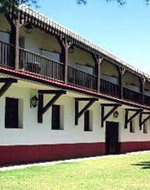 |
Parador
de Albacete, Albacete
Located on the plains of
La Mancha, in a setting which offers the appropriate conditions for open-air
activities, the Parador offers the traveller all the privileges necessary
to enjoy a peaceful, relaxed stay. The garden and the swimming pool create
an atmosphere which invites you to rest, to stroll or to have a refreshing
dip on warm summer evenings. This La Mancha country house, with its attractive
corridor, is characterized on the inside by an elegant simplicity, where
the natural light acquires prominence. Large windows and immaculate wood
combine with the luminosity of comfortable bedrooms. The 9 Hole Pitch
& Putt Golf Course and Putting Green is open to the public. Pitch and
Putt is like normal golf but with shorter distances between the holes.
Take advantage of it during your stay, bring your golf clubs! |

Ciudad
Real - Almagro |
|

| Almagro is a city situated
in Ciudad Real province, in the autonomous community of Castile-La Mancha,
Spain.
A tourist destination, Almagro is
an important Historical-Artistic Zone (Conjunto Histórico-Artístico).
The city lies within small Paleozoic
mountain ranges, with some reserves of shallow creeks, including the Pellejero
and de Cuetos. It also lies within a volcanic zone (Cerrro de la Yezosa),
which lies upon a quartzite massif. It makes the zone particularly unique,
together with that of the zones of Olot and Cabo de Gata, in the sense
that it is one of the few important zones of volcanic origin in the Iberian
Peninsula. |

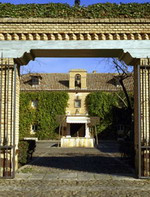 |
Parador
de Almagro, Almagro, Ciudad Real Province
The Convent of San Francisco
was built by the Dávila de la Cueva in 1596. It is located in an
area of outstanding historic and artistic interest just 5 minutes from
the main square. Here visitors have the opportunity to discover the prettiest
corners of the town, including the ‘corral de comedias’ (open-air theatre)
and the surrounding nature reserves. The interior decoration is finished
with beautiful galleries, woodwork and lattices. The Parador’s restaurant
provides traditional Manchegan cuisine with Arabic influences. The rooms
within the hotel are welcoming and have a stylish feel, featuring 14 interior
courtyards and a swimming pool. The bedrooms are found in the former monastic
cells, providing peace and serenity. |

Ciudad
Real - Manzanares |
|

| Manzanares
- A picturesque
town in the Sierra de Guadarama at the foot of La Pedriza mountain. Its
15th century castle is a jewel of civil architecture. It is worthwhile
taking a stroll through La Pedriza park and along the banks of the Manzanares
river. Location is 47 Kilometers from Madrid. |

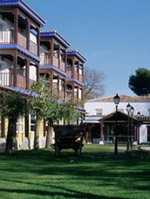 |
Parador
de Manzanares, Manzanares, Ciudad Real
Located in a La Mancha style
country house in Manzanares, the Parador De Manzanares is placed between
three most beautiful nature reserves of the country, which are Cabaneros,
the Ruidera Lagoons and the Tablas De Daimiel. Trees, bushes, gardens,
and plants impregnate this place with greenery, and with its swimming pool
make for a very appetising setting within the La Mancha countryside. The
hotel has well-appointed rooms that are equipped with modern amenities,
provides an affable and friendly atmosphere. You can dine at the
onsite restaurant, which serves regional specialities and also enjoy a
fine drink at the bar. Conference facilities are available for people
on business travel. During leisure, you can relax at the pool or explore
the city. |

Cuenca |
|

| Cuenca is a city in the autonomous
community of Castilla-La Mancha in central Spain. It is the capital of
the province of Cuenca, one of the largest provinces in Spain (17,061 km2.),
almost as large as countries like Slovenia or Montenegro. Renowned
for its "Casas Colgadas", or hanging houses, the city is literally hewn
out of rock. Wonderful countryside and views.
The city is a popular day or weekend
trip from Madrid. to which it is conveniently connected by rail (RENFE)
and by Bus (Auto Res 2 hour or 2:30 hour trip duration). It is very easy
to reach Cuenca from Madrid (166 km), taking the A-3 (Madrid - Valencia)
and leaving at Tarancón (km 79) junction to take the N-400 / A-40
to Cuenca. Within two or three years a new high-speed rail link is foreseen
to be set up between Cuenca and Madrid, making the trip last only 45 minutes. |

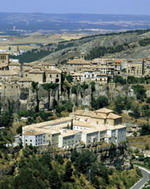 |
Parador
de Cuenca, Cuenca
16th Century Convent facing
the hanging houses. The former San Pablo convent sits in a privileged
location on the Hoz del Huécar gorge, comprising steep walls and
luxuriant vegetation outside Cuenca, facing the hanging houses. The
glazed cloister and old chapel - today a cosy café - are the perfect
complement to the interior combining traditional features with more contemporary
touches such as wicker, leather and upholstery. The cosy, comfortable
hotel rooms - some with splendid views of the hanging houses - are a highlight
as are the conference rooms, the bar and marvellous dining room decorated
with exquisite taste. Well-spiced seasonal fare makes up the base
of traditional Cuenca cuisine. The morteruelo creamy pâté,
hash with potted pork loin and roasts are standout, as are the traditional
desserts... |


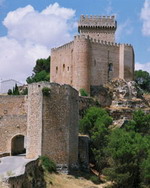 |
Parador
de Alarcón, Alarcón, Cuenca Province
This authentic 8th Century
fortress is situated on a promontory above the meandering river Júcar,
on the Manchego-Levantinas border. The hotel occupies the medieval castle
of the Marqueses de Villena, which is over 13 centuries old. Magnificent
oak and a mixture of modern and classical styles have transformed this
Parador into a new building. The fabrics used within bring out its medieval
character; the reds and oranges contrast with the austerity of the space
and serve as a backdrop for its genuine art collection. The Parador
de Alarcón cuisine is based on the famous ‘conquenese’ cuisine comprising
pickled partridge, duck and game pâtés, and Manchegan ingredients
such as Morteruelo (hot meat pâté), Zarajos (fried lamb’s
intestines) and Pisto Manchego (marrow with onion and tomato). |

Guadalajara
- Sigüenza |
|

| Sigüenza (in Latin Segontia)
is a city in the province of Guadalajara in Spain. A beautiful and inviting
city, enriched by the passing of time although its medieval character is
relatively unchanged. Stroll through the winding streets of the city contemplating
interesting monuments and visiting shops filled with local artisan crafts. |

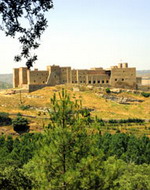 |
Parador
de Sigüenza, Sigüenza - Guadalajara Province
Installed in an Arab fortress,
built on Roman foundations, the construction began in 1123 of this imposing
castle, home of bishops, cardinals and kings. This is an appropriate base
for exploring the historic town and the beautiful landscape around it.
The hotel’s traditional Castilian furnishings are tastefully displayed
in the large, comfortable rooms, some with canopied beds and terraces,
authentic royal bedchambers in a palace which has kept its lordly halls,
ideal for meetings and celebrations, and a 13th century Romanesque chapel.
Within its thick stone walls is the cobbled courtyard and an imposing dining
room, where you can enjoy fried eggs with breadcrumbs and lardoons, oven
roast baby kid, cod with Manchego cheese, and for dessert the famous borrachitos
seguntinos and flores de Cabanillas. |

Madrid
- Chinchón |
|

| Chinchón is a Spanish
town 50 km southeast of Madrid. It is part of the Comarca de Las Vegas.
The Plaza Major is roughly circular,
surrounded by XV-XVII century galleried houses and cafés and is
used as a temporary bullring. The church of Nuestra Señora de la
Ascunción was built in the XV and XVI centuries. It contains a fine
early work by Goya depicting the Assumption of the Vigin. There is also
a medieval castle.
Though small, Chinchón is
known for its festivals, a big draw for people from nearby Madrid, and
those visiting it. Two of the biggest are the Chinchón Festival
de anis y vino, a celebration of locally distilled anisette and wine, which
takes place and the end of March, and the October garlic festival. |

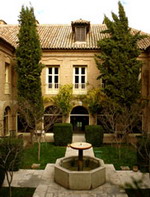 |
Parador
de Chinchón, Chinchón
Founded by the Lords of
Chinchón in the 17th century, this former Augustinian convent houses
monumental character set amongst that of Chinchón old town, with
its emblematic Plaza Mayor main square. Cypress trees, roses and wild privets
in the garden give a beautiful appearance, finished by the marvellous cloister
and softened by the blue water in the pool. Large windows and vaults,
classical Castilian furnishing and the pretty, spacious rooms make up the
hotel interior, characterised by a peaceful serene atmosphere. Head
to either of the Parador’s two restaurants: "El Convento" and "El Bodegón".
The first offers you the chance to savour exquisite dishes based on traditional
cuisine with a signature touch. We recommend the tasting menu and dishes
made with produce from Chichón plain. El Bodegón opens at
the weekend and on holidays, offering an alternative thematic cuisine:
Cocido Completo Taba (Taba chickpea and sausage stew served over two courses)
is a popular Madrid dish based on an original recipe from the late 19th
century. |

Toledo |
|

| Toledo is a municipality
located in central Spain, 70 km south of Madrid. It is the capital of the
province of Toledo and of the autonomous community of Castile-La Mancha.
It was declared a World Heritage Site by UNESCO in 1986 for its extensive
cultural and monumental heritage as one of the former capitals of the Spanish
Empire and place of coexistence of Christian, Jewish and Moorish cultures.
Many famous people and artists were born or lived in Toledo, including
Al-Zarqali, Garcilaso de la Vega, Alfonso X and El Greco. It was also the
place of important historic events such as the Visigothic Councils of Toledo. |

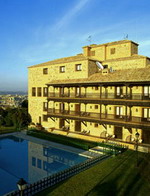 |
Parador
de Toledo, Toledo
On the hill called Cerro
del Emperador by a meander of the river Tajo, this hotel in Toledo offers
an unequalled panorama of the monumental silhouette, with its greatest
jewels, the Cathedral, the Alcázar and the synagogues. In the hotel
you can also enjoy the refreshing swimming pool and plan outdoor leisure
activities. From the bedrooms, lounges, terrace and pool the beautiful
views of the Imperial City dominate, while the interior is remarkable for
its spaciousness and luxury. Comfortable furnishings combine with
wooden beams, staircases and balustrades, and Mudejar elements in rugs
and tiles. The dining room offers typical dishes from Castilla -
La Mancha, such as stewed partridge Toledo style, roast lamb, cream cheese
and honey ice cream and the famous marzipans of Toledo. |

Toledo
Province - Oropesa |
|

| Oropesa is a Spanish town
in the province of Toledo. The town of 2,872 is famous for its castle-turned-parador,
which was built in 1402. The parador was formerly the residence of the
Toledo family of nobles. This includes Francisco de Toledo, Count of Oropesa,
who became the Viceroy of Peru.
The town has a yearly celebration
in April called "Jornadas Medievales", or "Medieval Days", which plays
off the presence of the Castle in Oropesa. |

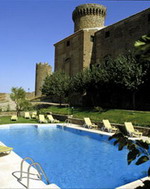 |
Parador
de Oropesa, Toledo Province
15th Century Palace and
Castle - The stately home of the Álvarez de Toledo, Counts of Oropesa,
once the home of soldiers, clergy and noblemen, enjoys exceptional views
of the Sierra de Gredos. The historic value of the Torre del Homenaje,
a tower attached to the Parador, the columns of the courtyard, and the
pool with outstanding views over the plains of Campo Arañuelo, make
up a very attractive hotel. The interior is dominated by lamps, chests
and curtains, with large, bright rooms, lounges and work spaces. Game and
seasonal produce are features of Oropesa, where the cookery of Toledo offers
lamb, roast kid and other specialities such as migas del Arañuelo,
a bread-based dish, and confit of partridge. |
 Top Top
|

